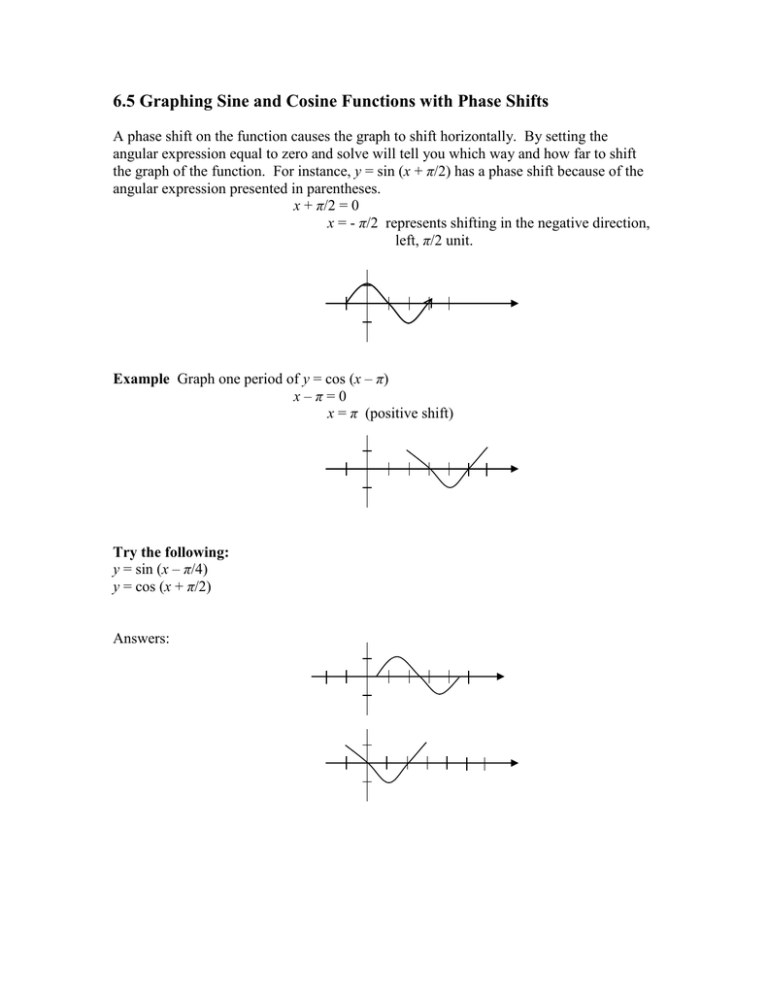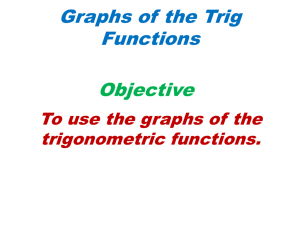6.5 Graphing Sine and Cosine Functions with Phase Shifts
advertisement

6.5 Graphing Sine and Cosine Functions with Phase Shifts A phase shift on the function causes the graph to shift horizontally. By setting the angular expression equal to zero and solve will tell you which way and how far to shift the graph of the function. For instance, y = sin (x + π/2) has a phase shift because of the angular expression presented in parentheses. x + π/2 = 0 x = - π/2 represents shifting in the negative direction, left, π/2 unit. Example Graph one period of y = cos (x – π) x–π=0 x = π (positive shift) Try the following: y = sin (x – π/4) y = cos (x + π/2) Answers: The graphs of sine and cosine functions can also exhibit a vertical shift. A vertical shift is determined by what is added, or subtracted, to the trig function. For instance, y = sin x + 2 has a vertical shift up 2 units, while y = sin x – 1 has vertical shift down 1 unit. Example Determine what kind of shift occurs and which direction it goes. Graph one cycle of the function y = sin x – 2 Vertical shift down 2 units Try the following: Determine what kind of shift occurs and which direction it goes. Graph one cycle of the functions: y = cos x + 1 y = sin x + 3 y = cos x – 4 Answers: Vertical shift up 1 unit Vertical shift up 3 units Vertical shift down 4 units To graph a trigonometric function with multiple transformations an order of operations is required. Various methods are said to be the order of transformations. In a nut shell, the vertical shift and horizontal shift are the last transformations to perform. It does not matter which shit you do last. Example Graph one period of y = -3sin (x + π/2) Vertical stretch factor of 3 Reflect across x-axis Horizontal shift left π/2 unit Example Graph one period of y = cos (2x – π) + 3 Period: 2π/2 = π Vertical shift up 3 units Horizontal shift right π/2 unit Try the following: Graph one period. y = -sin ( ½ x + π/4) y = 2cos x – 4 y = cos (x + π/2) – 1 y = -4sin (2x + π) + 3 Answers: Period: 2π/ ½ = 4π Reflect across x-axis Horizontal shift left π/2 unit Period: 2π/1 = 2π Vertical stretch factor 2 Vertical shift down 4 units Period: 2π/1 = 2π Vertical shift down 1 unit Horizontal shift left π/2 unit Period: 2π/2 = π Reflect across x-axis Vertical stretch factor 4 Vertical shift up 3 units Horizontal shift left π/2 unit My recommended method for transforming the trigonometric functions: 1. accommodate period of trig function 2. vertically stretch and/or reflect 3. shift vertically and/or horizontally




